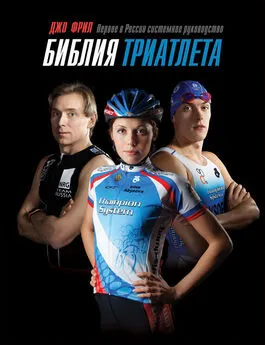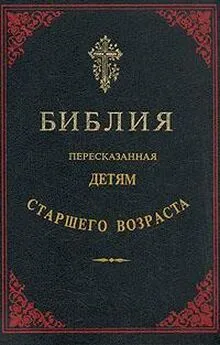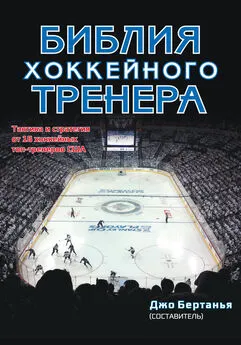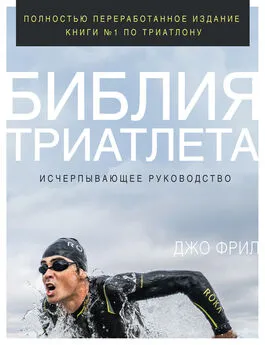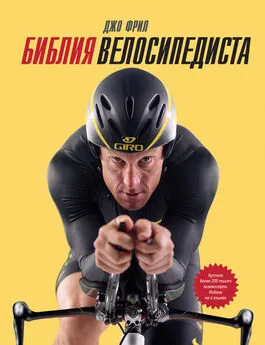Джо Фрил - Библия триатлета
- Название:Библия триатлета
- Автор:
- Жанр:
- Издательство:Манн, Иванов и Фербер
- Год:2011
- Город:Москва
- ISBN:978-5-91657-184-4
- Рейтинг:
- Избранное:Добавить в избранное
-
Отзывы:
-
Ваша оценка:
Джо Фрил - Библия триатлета краткое содержание
Эта книга поможет вам подготовиться к соревнованиям: спринт-триатлону, олимпийской дистанции, Half-Ironman и, наконец, полному Ironman. В ней учтены особенности тренировки самых разных групп спортсменов: по полу, возрасту, уровню начальной подготовки. Четкая структура, понятные описания, иллюстрации и удобные таблицы контрольных данных позволят вам разработать собственную систему тренировок, а затем планомерно идти к вашей высокой цели.
Эта книга совершенно необходима всем, кто уже занимается триатлоном или только собирается им заняться.
Библия триатлета - читать онлайн бесплатно ознакомительный отрывок
Интервал:
Закладка:
Niles, R. Time-Saving Training for Multisport Athletes . Champaign, IL: Human Kinetics, 1997.
Nissen, S. L., and Sharp, R. L. Effect of Dietary Supplements on Lean Mass and Strength Gains with Resistance Exercise: A Meta-Analysis // Journal of Applied Physiology 94, no. 2 (2003): 651–659.
Noakes, T. D. Implications of Exercise Testing for Prediction of Athletic Performance: A Contemporary Perspective // Medicine and Science in Sports and Exercise 20, no. 4 (1988): 319–330.
Noakes, T. D. The Lore of Running . Champaign, IL: Leisure Press.
Noakes, T. et al. Effects of a Low-Carbohydrate, High-Fat Diet Prior to Carbohydrate Loading on Endurance Cycling Performance // Clinical Science 87 (1994): S32–S33.
Nose, H. et al. Involvement of Sodium Retention Hormones during Hydration in Humans // Journal of Applied Physiology 65 (1988): 325–331.
O’Brien, C. et al. Glycerol Hyperhydration: Physiological Responses during Cold-Air Exposure // Journal of Applied Physiology 99 (2005): 515–521.
Okkels, T. The Effect of Interval-and Tempo-Training on Performance and Skeletal Muscle in Well-Trained Runners // Twelfth European Track Coaches Congress . Acoteias, Portugal (1983): 1–9.
Orlick, T. Psyched to Win . Champaign, IL: Leisure Press, 1992.
Orlick, T. Psyching for Sport . Champaign, IL: Leisure Press, 1986.
O’Toole, M. L. Prevention and Treatment of Injuries to Runners // Medicine and Science in Sports and Exercise 24, no. 9 (1992): 360–363.
O’Toole, M. L., and Douglas, P. S. Applied Physiology of Triathlon // Sports Medicine 19, no. 4 (1995): 251–267.
O’Toole, M. L. et al. Fluid and Electrolyte Status in Athletes Receiving Medical Care at an Ultradistance Triathlon // Clinical Journal of Sports Medicine 5, no. 2 (1995): 116–122.
O’Toole, M. L. et al. Overuse Injuries in Ultraendurance Triathletes // American Journal of Sports Medicine 17 (1989): 514–518.
Parizkova, J. Body Composition and Exercise during Growth and Development // Physical Activity: Human Growth and Development (1974).
Pate, R. R., and Branch, J. D. Training for Endurance Sport // Medicine and Science in Sports and Exercise 24, no. 9 (1992): S340–343.
Pate, R. R. et al. Cardiorespiratory and Metabolic Responses to Submaximal and Maximal Exercise in Elite Women Distance Runners // International Journal of Sports Medicine 8, no. S2 (1987): 91–95.
Pendergast, D. R. et al. A Perspective on Fat Intake in Athletes // Journal of the American College of Nutrition 19, no. 3 (2000): 345–350.
Peters, E. M. et al. Anti-Oxidant Nutrient Supplementation and Symptoms of Upper Respiratory Tract Infections in Endurance Athletes // Medicine and Science in Sports and Exercise 26, no. 5 (1993): S218.
Peyrebrune, M. C. et al. The Effects of Oral Creatine Supplementation on Performance in Single and Repeated Sprint Training // Journal of Sports Science 16, no. 3 (1998): 271–279.
Phinney, S. D. et al. The Human Metabolic Response to Chronic Ketosis with Caloric Restriction and Preservation of Submaximal Exercise Capabilities with Reduced Carbohydrate Oxidation // Metabolism 32 (1983): 769–776.
Pollock, M. et al. Effect of Age and Training on Aerobic Capacity and Body Composition of Master Athletes // Journal of Applied Physiology 62, no. 2 (1987): 725–731.
Pollock, M. et al. Frequency of Training as a Determinant for Improvement in Cardiovascular Function and Body Composition of Middle-Aged Men // Archives of Physical Medicine and Rehabilitation 56 (1975): 141–145.
Remer, T., and Manz, F. Potential Renal Acid Load of Foods and Its Influence on Urine pH // Journal of the American Dietetic Association 95, no. 7 (1995): 791–797.
Reuter, B. H., and Wright, G. Overuse Injury Prevention in Triathletes // Strength and Conditioning 18, no. 6 (1996): 11–14.
Richardson, A. B., and Miller, J. W. Swimming and the Older Athlete // Clinical Sports Medicine 10, no. 2 (1991): 301–318.
Riegel, P. Athletic Records and Human Endurance // American Scientist 69 (1981): 285–290.
Robergs, R. A. Glycerol Hyperhydration to Beat the Heat? // Sportscience , 1998. www.sportsci.org/traintech/glycerol/rar.htm.
Robinson, S. Temperature Regulation in Exercise // Pediatrics 32 (1963): 691–702.
Rogers, M. A. et al. Decline in V02Max with Aging in Masters Athletes and Sedentary Men // Journal of Applied Physiology 68, no. 5 (1990): 2195–2199.
Romanov, N. S., with Robson, J. Dr. Nicholas Romanov’s Pose Method of Running . Coral Gables, FL: PoseTech Press, 2002.
Romijn, J. A. et al. Regulation of Endogenous Fat and Carbohydrate Metabolism in Relation to Exercise Intensity and Duration // American Journal of Physiology 265 (1993): E380.
Rushall, B. Psyching in Sport: The Psychological Preparation for Serious Competition in Sport . London: Pelham Books, 1979.
Rushall, B. S. A Tool for Measuring Stress Tolerance in Elite Athletes // Applied Sport Psychology 2 (1990): 51–66.
Rushall, B. S. Some Psychological Considerations for U.S. National Swimming Teams // American Swimming , February-March (1994): 8–12.
Sale, D. G., and MacDougall, D. Specificity in Strength Training: A Review for the Coach and Athlete // Canadian Journal of Applied Sport Sciences 6 (1981): 87–92.
Sale, D. G. et al. Comparison of Two Regimens of Concurrent Strength and Endurance Training // Medicine and Science in Sports and Exercise 22, no. 3 (1990): 348–356.
Schatz, M. P. Easy Hamstring Stretches // Physician and Sports Medicine 22, no. 2 (1994): 115–116.
Schena, F. Branched-Chain Amino Acid Supplementation during Trekking at High Altitude // European Journal of Applied Physiology 65 (1992): 394–398.
Schneider, D. A. et al. Ventilatory Threshold and Maximal Oxygen Uptake during Cycling and Running in Triathletes // Medicine and Science in Sports and Exercise 22, no. 2 (1990): 257–264.
Schumacher Y. O., and Mueller, P. The 4000-m Team Pursuit Cycling World Record: Theoretical and Practical Aspects // Medicine and Science in Sports and Exercise 34, no. 6 (2002): 1029–1036.
Seals, D. R. et al. Endurance Training in Older Men and Women // Journal of Applied Physiology 57 (1984): 1024–1029.
Seiler, K. S., and Kjerland, G. O. Quantifying Training Intensity Distribution in Elite Endurance Athletes: Is There Evidence of an Optimal Distribution? // Scandinavian Journal of Medicine and Science in Sports 18, no. 2 (2008): 212–220.
Sharp, N. C. C., and Koutedakis, Y. Sport and the Overtraining Syndrome // British Medical Journal 48, no. 3 (1992): 518–533.
Shasby, G. B., and Hagerman, E C. The Effects of Conditioning on Cardiorespiratory Function in Adolescent Boys // Journal of Sports Medicine 3 (1975): 97–107.
Simon, J. et al. Plasma Lactate and Ventilation Thresholds in Trained and Untrained Cyclists // Journal of Applied Physiology 60 (1986): 777–781.
Simonson, J. C. et al. Dietary Carbohydrate, Muscle Glycogen, and Power Output during Rowing Training // Journal of Applied Physiology 70 (1991): 1500–1505.
Sleamaker, R., and Browning, R. Serious Training for Serious Athletes . Champaign, IL: Leisure Press, 1996.
Sleivert, G. G., and Rowlands, D. S. Physical and Physiological Factors Associated with Success in the Triathlon // Sports Medicine 22, no. 1 (1996): 8–18.
Sleivert, G. G., and Wenger, H. A. Physiological Predictors of Short-Course Triathlon Performance // Medicine and Science in Sports and Exercise 25, no. 7 (1993): 871–876.
Somer, E. The Essential Guide to Vitamins and Minerals . New York: HarperCollins, 1992.
Speechly, D. P., Taylor, S. R., and Rogers, G. G. Differences in Ultra-Endurance Exercise in Performance-Matched Male and Female Runners // Medicine and Science in Sports and Exercise 28 (1996): 359–365.
Stahl, A. B. Hominid Dietary Selection before Fire // Current Anthropology 25, no. 2 (1984): 151–168.
Steed, J. C. et al. Ratings of Perceived Exertion (RPE) as Markers of Blood Lactate Concentration during Rowing // Medicine and Science in Sports and Exercise 26 (1994): 797–803.
Steinacker, J. M. et al. Training of Rowers before World Championships // Medicine and Science in Sports and Exercise 30, no. 7 (1998): 1158–1163.
Stone, M. et al. Overtraining: A Review of the Signs, Symptoms, and Possible Causes // Journal of Applied Sport Sciences 5, no. 1 (1991): 35–50.
Stone, M. H. et al. Health– and Performance-Related Potential of Resistance Training // Sports Medicine 11, no. 4 (1991): 210–231.
Svedenhag, J., and Sjodin, B. Physiological Characteristics of Elite Male Runners In– and Off-Season // Canadian Journal of Applied Sport Sciences 10, no. 3 (1985): 127–133.
Taimura, A., Sugahara, M. Effect of Fluid Intake on Performance, Body Temperature, and Body Weight Loss during Swimming Training // Medicine and Science in Sport and Exercise 28, no. 5 (1996): S940.
Thomas, D. Q. et al. Changes in Running Economy and Mechanics during a Submaximal 5-Km Run // Journal of Strength and Conditioning Research 9, no. 3 (1995): 170–175.
Thompson, P. D. et al. The Effects of High-Carbohydrate and High-Fat Diets on the Serum Lipid and Lipoprotein Concentrations of Endurance Athletes // Metabolism 33 (1984): 1003–1010.
Thorland, W. G. et al. Strength and Anaerobic Responses of Elite Young Female Sprint and Distance Runners // Medicine and Science in Sports and Exercise 19: 56–61.
Tipton, C. M. et al. The Influence of Physical Activity on Ligaments and Tendons // Medicine and Science in Sports and Exercise 7 (1975): 165–175.
Toussaint, H. M. Differences in Propelling Efficiency between Competitive and Triathlon Swimmers // Medicine and Science in Sports and Exercise 22, no. 3 (1990): 409–415.
Toussaint, H. M., and Hollander, A. P. Energetics of Competitive Swimming: Implications for Training Programs // Sports Medicine 18 (1994): 384.
Toussaint, H. M. et al. Effect of Triathlon Wetsuit on Drag during Swimming // Medicine and Science in Sports and Exercise 21 (1989): 325.
Town, G., and Kearney, T. Swim, Bike, Run. Champaign, IL: Human Kinetics, 1994.
Triathlon: Achieving Your Personal Best / ed. R. Cedaro. New York: Facts on File, 1993.
Ungerleider, S. Mental Training for Peak Performance . Emmaus, PA: Rodale Sports, 1996.
Urhausen, A. et al. Blood Hormones as Markers of Training Stress and Overtraining // Sports Medicine 20 (1995): 251–276.
Vanderburgh, H., and Kaufman, S. Stretch and Skeletal Myotube Growth: What Is the Physical to Biochemical Linkage? // Frontiers of Exercise Biology / ed. K. Borer et al. Champaign, IL: Human Kinetics, 1983.
VanHandel, P. J. Planning a Comprehensive Training Program // Conditioning for Cycling 1, no. 3 (1991): 4–12.
VanHandel, P. J. The Science of Sport Training for Cycling, Part I // Conditioning for Cycling 1 , no. 1 (1991): 8–11.
VanHandel, P. J. The Science of Sport Training for Cycling, Part II // Conditioning for Cycling 1 , no. 2 (1991): 18–23.
VanHandel, P. J. Specificity of Training: Establishing Pace, Frequency, and Duration of Training Sessions // Bike Tech 6, no. 3 (1987): 6–12.
Читать дальшеИнтервал:
Закладка:
